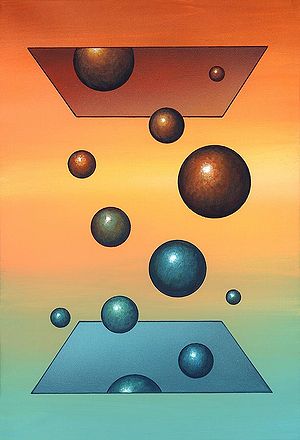First Law of Thermodynamics: Difference between revisions
| Line 58: | Line 58: | ||
* http://hyperphysics.phy-astr.gsu.edu/hbase/thermo/firlaw.html | * http://hyperphysics.phy-astr.gsu.edu/hbase/thermo/firlaw.html | ||
* [http://www.wiley.com/college/moran/CL_0471465704_S/thermonet/docs/user/index.html ThermoNet] | * [http://www.wiley.com/college/moran/CL_0471465704_S/thermonet/docs/user/index.html ThermoNet] | ||
*[https://www.khanacademy.org/science/physics/thermodynamics/laws-of-thermodynamics/v/first-law-of-thermodynamics-internal-energy Khan Academy: First Law of Thermodynamics] | |||
==References== | ==References== | ||
Revision as of 04:11, 19 April 2016

Thermodynamics is concerned with energy change and how heat, temperature, energy, and work are correlated.
The Main Idea
The First Law of Thermodynamics states that all thermodynamic systems have a property called energy, and that energy can be neither created nor destroyed. Even if the energy cannot be created or destroyed, power generation process and energy sources help the conversion of the energy from one form to an another.
A Mathematical Model
[math]\displaystyle{ ∆U = Q-W }[/math] where [math]\displaystyle{ ∆U }[/math] is change in the internal energy , [math]\displaystyle{ Q }[/math] is heat added to the system, and [math]\displaystyle{ W }[/math] is the work done by the system. In other words, change in internal energy is equal to flow of heat into a system minus work done on the system. While both [math]\displaystyle{ Q }[/math] and [math]\displaystyle{ W }[/math] are path functions, [math]\displaystyle{ ∆U }[/math] is a path-independent state function, which means that it only depends on the current state of the system.
A Computational Model
http://jersey.uoregon.edu/vlab/Thermodynamics/
This virtual experiment gives you visual representation of thermal equilibrium and how it is reached when beginning with different initial conditions.
Examples
Solving for Change in Internal Energy
If 500 J of work is done on a system, and it gains 100 J of heat from its surroundings, then what is the change in internal energy of the system?
Solution:
[math]\displaystyle{ ∆U = Q-W }[/math], [math]\displaystyle{ Q= 100 J }[/math], [math]\displaystyle{ W=-500 J }[/math]
[math]\displaystyle{ ∆U = 100 J -(-500 J) }[/math]
[math]\displaystyle{ ∆U = 600 J }[/math]
Connectedness
1. How is this topic connected to something that you are interested in?
- Thermodynamics is seen in all aspects of life, in everything from melting ice cubes to flipping switches to cooking.
2. How is it connected to your major?
- Thermodynamics is useful to know, and is covered in the Fundamentals of Engineering exam. Engineers interested in passing the FE and other similar tests should have a strong foundation in thermodynamics.
3. Is there an interesting industrial application?
- Thermodynamics is relevant in the energy,transportation, and HVAC industries.
History
The First Law of Thermodynamics, in its current state, was first explicitly expressed by Clausius in 1850. In his Mechanical Theory of Heat, he stated that "in a thermodynamic process involving a closed system, the increment in the internal energy is equal to the difference between the heat accumulated by the system and the work done by it."
See also
Are there related topics or categories in this wiki resource for the curious reader to explore? How does this topic fit into that context?
Further reading
- Thermodynamics (Dover Book on Physics) by Enrico Fermi
- Engineering Thermodynamics by P. K. Nag
- M. J. Moran and H. N. Shapiro, ‘Fundamentals of Engineering Thermodynamics’, Fourth Edition, Wiley, New York, 2000
- Thermodynamics: An Engineering Approach by Cengel, Ya and Boles, M.A.
External links
- http://www.scientificamerican.com/article/bring-science-home-reaction-time/
- http://www.physlink.com/Education/AskExperts/ae280.cfm
- http://web.mit.edu/16.unified/www/FALL/thermodynamics/notes/node15.html
- http://hyperphysics.phy-astr.gsu.edu/hbase/thermo/firlaw.html
- ThermoNet
- Khan Academy: First Law of Thermodynamics
References
- Callen, Herbert B. (1985). Thermodynamics and an Introduction to Thermostatistics. Wiley. p. 5,37.
- http://fineartamerica.com/featured/1-thermodynamics-conceptual-artwork-richard-bizley.html
- http://www.humanthermodynamics.com/Clausius.html
- http://web.mit.edu/16.unified/www/FALL/thermodynamics/notes/node15.html